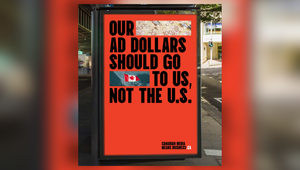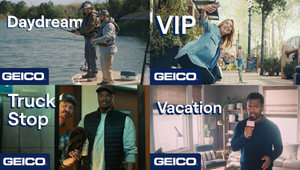
Advertising Embraces Adult Animation’s Existential Turn

In 1989 The Simpsons showed that cartoons could tackle serious topics like marital tensions and tight finances. In the ‘90s the foul-mouthed edgelords of South Park were gloriously – or ingloriously – smashing every taboo they could. Hell, back in the ‘30s and ‘40s Betty Boop was busy administering novocaine to clowns and horny anthropomorphised wolves were busy #MeToo-ing famous fairy tale characters.
Animation has always been for adults. But the past decade has seen a new wave of adult-orientated animated TV and streaming series that draw together the hallucinogenic fluidity of the early days with the anxieties, neuroses and existential angst of fake news-era 21st century. With its unashamedly literary ambitions, Bojack Horseman, a cartoon about a talking horse, may well be The Great American Animation. (I’m quite prepared to fight you on that). Big Mouth shows tweens tussling with puberty, depression and even menopause with paradoxically puerile maturity. And then there’s Rick and Morty. A nihilistic cartoon series that started life as a Back to the Future parody has become a global phenomenon, triggering riots in McDonald’s around the USA and, in 2017, becoming American millennials’ favourite comedy show – ahead of Modern Family and The Big Bang Theory . And, lest we forget, millennials are pushing 40 these days.
Mark Brooks is creative director at Titmouse Los Angeles, and he’s at the frontline of the new wave. Titmouse is the team behind early front runners Metalocalypse (2006) and the superlative The Venture Bros (2003) as well as more recent adult hits Black Dynamite and Big Mouth. From his perspective, there’s never been more of an appetite. “The best time to be in animation is right now. It’s an exciting time. There are so many animation outlets that lots of cool projects pushing boundaries are getting to see the light of day,” he says. “We’re seeing a generation now that has grown up on adult animation. The audience is much, much larger than it was when I was a teenager.”
Golden Wolf founder Ingi Erlingsson reckons that another driver behind the growing appeal of animated TV series for adults is the explosion of streaming services, which are hungry for content. One just needs to look at Netflix - which has found itself with a storming hit on its hands with live action Henry Cavill fantasy Witcher - to keep fans sated while they shoot the next series, they’ve announced an animated prequel.
“Animation still struggles with legitimacy in the ’grown up’ entertainment world, often assumed to be mostly for kids, especially in the West. The good news is that platforms like Netflix and Amazon are commissioning more and more content that raises the bar for adult animated entertainment, pushing it to its full potential with projects like Undone and Love Death & Robots,” says Ingi.
“The same is happening in the advertising world too. Agencies are finding more uses for animation and specifically animated characters, which are often able to transcend cultural and political barriers and biases.”
Rick and Morty Head to the Super Bowl
Unsurprisingly, given their popularity, the cynical space traveller and his tightly-wound grandson have been embraced by advertisers. This week the pair turned up in an AT&T commercial about Google Assistant-powered TV from BBDO – and back at the beginning of February they featured in a Super Bowl spot for Pringles from Grey New York. In November 2019, they teamed up with PlayStation and legendary video game designer Hideo Kojima to promote the launch of twisted game Death Stranding.
According to Jill King, the SVP of consumer & partnership marketing at Adult Swim, which airs the cartoon in the US, the key to a successful brand partnership is to give the show’s creatives control. If you’ve ever watched an episode of the show – particularly the recent ‘slutdragon’ episode – you’ll know that it’s a prospect that requires nerves of steel.
“We get asked by brands all the time saying that they want to do something with Rick and Morty and we have to have complete creative control because that's the only way it’s going to be additive to the Rick and Morty universe. I think young people are marketed to so much that they’ll pull us up if it’s not real,” says Jill.
“Our approach to anything we do on the partnership side is to make it meaningful. It also serves as marketing for us – it’s a surprise and delight moment that no one was expecting when we dropped the Pringles stuff.”
The rewards for brands who get it right are huge. In the USA it’s the most popular comedy for people aged 18-49 – and, says Jill, the upper age limit for Rick and Morty fans is increasing. Adult Swim fans who fell in love with the channel during their college years are now using it to escape and unwind after a busy day of work and family commitments.
What’s more, the diversity of the audience for this gross-out, sci-fi comedy might surprise you (unless, like me, you’re a 35-year-old woman who mainlines the stuff).
“It’s a very gender-neutral show, but the casual viewer is more female,” says Jill. She explains that their own research shows that the series appeals to couples. Usually one half of the relationship is a die-hard fan who has watched it many times over – and their partner would then get sucked in. The overall trend, she notes is that female viewers who might have dismissed sci-fi animation are sucked in by the twisted family dynamic. “One of our key learnings was that after you watch Rick and Morty three to four times, you fall in love with it.”
Habito Horror
Adult Swim isn’t alone in finding that its audience of teenage slackers and nerds have grown up to become reasonably functioning adults, capable of relationships and even spawning. The demographic for the weirder reaches of animation has grown up. And you don’t get much more grown up than mortgages.
UK online mortgage broker Habito has vaporised every cliché in mortgage marketing with their ‘Hell or Habito’ campaign from Uncommon London. Instead of aspirational couples in dungarees painting nurseries yellow, we’ve got a wild campaign that brings the very real horror of house buying to life. It makes for eye-catching outdoor and an entertaining, ongoing animated campaign.
“Essentially our business strategy is to become the place where you go for everything to do with mortgages, so all we want you to remember is Habito - where mortgage hell is no more. So, yes, cutting through, being different, being memorable are the most important facets of the campaign,” says Habito CMO Abba Newbery. “Our core audience are in their 30s and 40s, and grew up with skateboarding, and Itchy & Scratchy as their cultural norms - so the execution strikes a great balance between disruption and nostalgia. We even sponsor the National Skateboard Championships, which is especially exciting now it is an Olympic sport.”

The visual style of Hell or Habito was initially inspired by skate artist Jimbo Phillips (who designed the print and outdoor) – lurid, vivid, intricate and visceral. Abba recalls that alongside the Jimbo illustrations, the original pitch involved gruesome Mortal Kombat-inspired finishing moves too.
“The original brief was to create a look for the spots that allowed us to show some pretty gruesome ideas in a way that was humorous enough to be shown on daytime tv without getting kicked off! With references ranging from Jimbo Phillips to Adult Swim shows like ‘King Star King’ we wanted to develop a style that felt unique for the brand and would cut through the other ads on TV when it came on,” explains Andy Baker, from Hornet, who directed the ads. “We spent a bit of time up-front working out the best way to make this style work for a relatively quick turnaround. We worked closely with Serge (character designer) to develop the look of the characters and with the background painters to create the heavily textured style in the films. We referenced a lot of old horror and B movie tropes for camera placement, which has evolved and refined as the spots have evolved.”
Animation allows creatives to take their ideas to the extreme. “When we’re talking about having people’s brains explode, we can actually do that with animation,” says Nils Leonard, co-founder and CCO at Uncommon. “What you can also do, which is far harder when you’ve got to cast, is play out the ugly reality. People are horrible. That werewolf ad is literally true – people will do anything to get the house they want. They become absolute dicks, they’re in that race.”
Nils also reckons that animation has a very different emotional dimension to live action. “Whenever you suggest animation – and it’s partly true – someone will say, ‘it’s less emotional than film!’. It is if you’re going for a tear-jerker. But if you’re going for other emotions, like rampant, ferocious energy, or hate, or frustration then it’s absolutely brilliant,” he says – with the all important caveat that one of his favourite animated movies, Kubo and the Two Strings, is a nerve-tingling emotional experience and a ’game changer’.
Over the past year, Habito has seen some very real results from the campaign. “From the very start of the campaign we have had amazing feedback across all our social channels about the campaign. It’s always astounding to me that people bother to comment on our ads on Twitter or Facebook or even Trustpilot. But the metrics speak for themselves. We’ve tripled brand awareness in 12 months, grown customers by 100% and reduced our acquisition cost by 75%. And we have nearly hit 8million views on Youtube,” says Abba.
KFC (Kwik, Fast, Communication)
Another place that animation shines is in the short, fast-paced and blippy advertising on social or TV. Extreme vivid colours connect quickly and the clipped run-time is perfect for a nugget of slapstick violence. KFC’s Christmas 2019 campaign is a perfect example, says Golden Wolf founder Ingi Erlingsson, who worked on the ads that amped up the stress of festive cooking.
“From my personal point of view, I think animation was the perfect medium for that campaign because it allows you to use a degree of cartoon violence that otherwise would have been a step too far for live action,” says Ingi. “There’s a strong Wile-e-Coyote parallel in those spots which I think people are quick to connect with, which helps as the spots were only 10 seconds long.”
That’s something that Mark at Titmouse is all too familiar with. Every year the animation house holds a 5 Second Animation Day, challenging their talent to create their own short shorts that have to be at least five seconds long. And, as he’s seen over the years, the team can pack a lot of anarchy and mayhem into a few seconds. “Animation is a particularly great tool for communicating quickly. A lot can be conveyed in a short amount of time with a cartoon,” he says. “Not to mention, anything is possible with animation.”
Short and sweet (and not-so-sweet, when the creative demands it) social animation is something that Mother London has been developing a speciality for. Not only are they the creative brains behind the KFC Christmas gorefests but last year they also whipped up a suite of snappy, helpful cartoons for IKEA, with Blink directors the Layzell Bros.
Cartoon Culture
Some of the shortcuts facilitated by animation are fairly universal, but many are culturally-specific. Animation comes in a plethora of styles, each with their own coding, but which means that advertisers do need to think carefully about what approach they take. That’s particularly true when it comes to animation inspired by series that appeal to both adults and children, like Adventure Time or Steven Universe.
“From a creative standpoint I think it’s important to understand who your target audience is and what their cultural references are… I saw an alcohol campaign recently that looked like a pre-school cartoon, which felt a bit off the mark,” says Ingi.
This current wave of angsty animation has a notably American influence, but it would be remiss to ignore the growing presence of Japanese-inspired anime that’s also filtering through to diverse markets around the world. It makes sense – the logic that says that fans of South Park are now adults with spending power also applies to anime fans who grew up on Cowboy Bebop, Neon Genesis Evangelion and Princess Mononoke. In Europe and America, we’ve seen brands lean into the gentle, highbrow fantasy of Studio Ghibli (the ongoing Portland tourism campaign from Psyop and Wieden+Kennedy is a sublime example, as is the recent UK Wagamama spot) or embrace the action and sci fi aesthetic for aggressive sports ads (ASICS from BBDO North America). Over in Asia, we’re seeing work created for a generation that spent its youth steeped in anime, with brands like Siemens getting involved, as well as beer brands reminding us that anime is for people who are old enough to drink. Anime also has just the same potential for extreme visual metaphors and over-the-top depictions of human emotion, and there’s a highly specific visual language that helps creators get to the point even faster. For a glimpse of this in action, Apple Japan’s recent outing cuts together clips of anime characters using MacBooks, and these tiny snippets communicate the characters’ personalities and states of mind instantly.
When it comes to developing new styles, techniques and visual short-hands to go along with them, things are a little slower. “I also think that it’s harder than it sounds to do something new in animation, like it is in film. I think there’s been a lot of animation,” says Nils. One of the best recent examples is the Oscar-winning Into the Spiderverse, where the creators spent two years in research and developing their look. It allowed them to pull in techniques from comic book storytelling and even mess about with the frame rate to punch up characterisation and action films. “In Spiderverse it was the glitches, it was the mixed media in a way you’d not seen. It’s very rare you see genuinely new animation in treatments,” adds Nils.
Word Bubbles
The practical and stylistic appeal of animation is clear, and from a demographic point of view, advertisers can tap straight into 20-40-somethings with a well-placed appeal to adult cartoons. But Ingi reckons that they might be missing the most fascinating part of the adult animation boom. The writing.
Afterall, fans wouldn’t keep coming back to shows like Rick & Morty in the volume that they do purely because of the aesthetic. The most successful animated series have been underpinned by talented writers with something to say. Rick & Morty co-creator Dan Harmon has also become known for his ‘story circle’ approach to writing, a rigorously distilled take on Joseph Campbell’s Hero’s Journey – an approach he refined on the live action sitcom Community. One only needs to see what happened to The Simpsons. 2019 saw ratings hit an all-time low, and while the animation may be slicker than ever, creator Matt Groening is long gone.
Brands keen to tackle difficult topics might, ironically, find that the capacity for metaphor and speed of communication allows them to pack in more nuance. The garish colour and gleeful slapstick violence might soften the blow of hard emotional truths. I don’t think I could have made it to the end of Bojack were it not for the filter of anthropomorphic animation.
“I guess in a strange way a lot of these shows feel like bigger triumphs for writing than they do for animation. Don’t get me wrong I really enjoy how they’re all animated, but a lot of TV content is pretty lo-fi compared with the stuff that gets us excited as animators,” says Ingi. “What I think is brilliant about these shows is that they’re able to tackle really complex issues in a really approachable way, that I’m not sure live action would be able to emulate as easily. Shows like Tuca & Bertie (which was sadly cancelled after just one season) brilliantly pushes buttons that most shows wouldn’t dare, helping redefine what a female-led show can be. As a show it’s really opened my eyes to what animation could look like for adults in the future and the types of issues we could tackle.”
A Blank Page
Despite the built-in audience, there’s still plenty of unexplored territories for brands and creatives to explore when it comes to adult animation.
For director Andy, the ongoing collaboration with Habito and Uncommon London has whetted his appetite. “It was definitely a very rare brief to get, and really refreshing for someone who loves animation and the Adult Swim / adult animation world,” he says. “To be honest, I’m surprised there hasn’t been more people tapping into this world as there’s so many great artists and really strong visual styles as well as great humour being created in the adult animation scene that I think lend themselves to creating really surprising and attention grabbing ads. Thankfully we got this brief and were able to work with some of the background painters who worked on a couple of those shows, to give that authentic, late-night animation feel too - which was awesome. Overall it’s been great to be given the time to develop the world of Hell or Habito through the six ads, much in the same way as you would in longer format animation, and it feels like it’s just getting started in terms of where it can go and what it could develop into.”
Nils too has got the bug. “I’m gonna go and do more fucked up animation for brands that shouldn’t have animation,” he says. “Can you imagine a brilliant, animated fragrance ad? I just want to make that. If anyone reads this and wants to make that ad, call me.”















